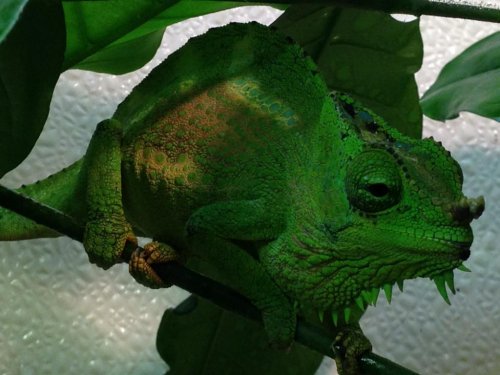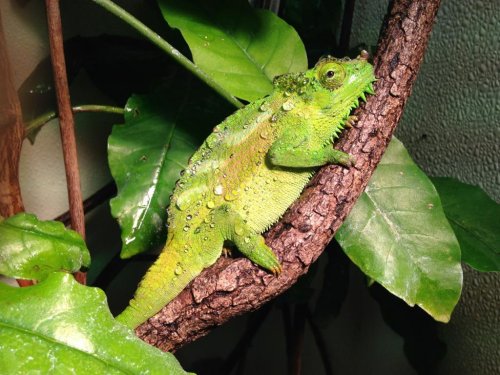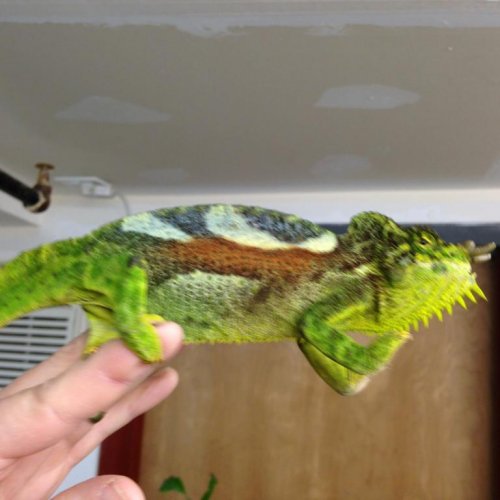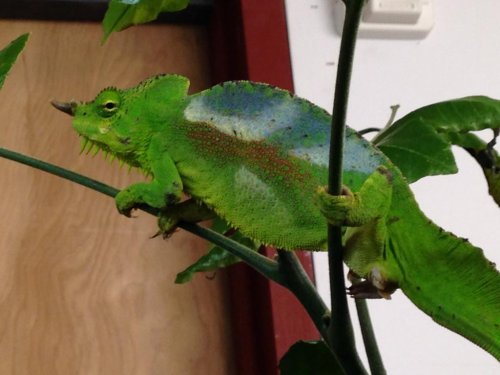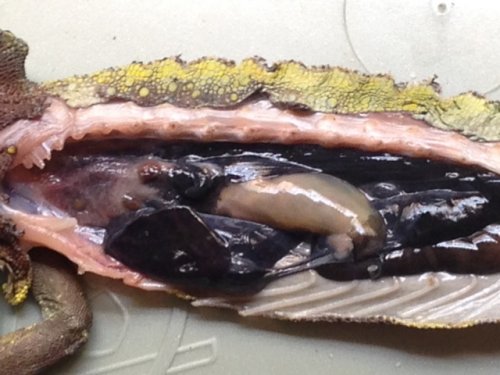pamnsam94
Established Member
I wasn't quite sure where to start this thread. At first, I thought maybe I should post in the "Memoriam" forum, but I thought it would be more appropriate here since I'm dealing with a subject that I'm sure many keepers have thought about.
This week has been a really tough one for me. Earlier this week, I lost two of my quads, Lazarus and Cerulean, from the December shipment. I don't know for sure what the exact cause of death was in either case, but I have my ideas.
A lot of us, both experienced and novice keepers, have no doubt wondered when to take action and what type of action to take with different health problems. Of course, each case is different depending on many variables. Some keepers, and even vets for that matter, take a more passive approach, depending on the health issue, while other keepers and vets might treat the same health problem more aggressively.
Most of us are aware of the general fragile nature of chameleons, especially wild caught animals, because they often come in with a variety of health issues. With their slow metabolisms, their road to recovery can be a really long one. Even captive born and bred chameleons are known to sometimes turn on a dime for the worse. Sometimes, what seems to be for no apparent reason, a chameleon can appear healthy in the morning but be dead later that day. Trying to determine a cause of death in those situations is often very difficult, even with a vet's assistance.
Thankfully though, many health issues take a while to fully manifest themselves, giving the keeper time to act to hopefully bring the chameleon back to good health. I want to share two such instances of a slow decline in health in order to help other keepers that might be struggling with similar situations.
Broadly speaking, it could be said that there are two general philosophies or approaches on how to treat certain health issues. You have the option to deal with a problem passively or aggressively. An example of a passive approach to newly imported animals would be to mainly focus on hydrating the chameleons and having an environment set up that minimizes stress, realizing that stress can easily lead to a decline in health. An example of an aggressive approach is to use the "shotgun" method in treating parasites, which assumes the chameleons are going to have some parasites. The chameleons are treated even before knowing what parasites they may or may not have.
It's can be tricky and nerve-racking sometimes when trying to decide when to treat something aggressively, with a lot of hands-on intervention, and when to use a more passive approach (e.g. primarily focusing on minimizing stress to allow the chameleon's immune system to be more effective). Sometimes, keepers and vets have to walk a fine line in deciding which approach to use. It's not an exact science and what works for one animal won't necessarily work for another because so many variables come into play.
Anyone who keeps chameleons long enough will eventually experience losing them due to either taking a too passive approach or due to being too aggressive. Sometimes the chameleon is doomed no matter what approach is used. Even an experienced exotics vet, who might see a lot of chameleons, will sometimes use the "wrong" approach which can result in the animal's death. Realizing this, we shouldn't be critical of another keeper just because they, or their vet, used a different approach than we would've used.
Now, having said that, I want to share some thoughts about the health issues that many of the quads from the recent Cameroon shipments had. After a fecal determined that some of the quads in the CA shipment had a lot of nematodes, word was spread that it would be a good idea to aggressively treat all the quads from that import with fenbendazole, considered a safe drug as long as the chameleon is well-hydrated. I really believe that was a wise choice.
Generally, west African chameleons from higher elevations have a reputation for not having nearly as high of a parasite load as east African species, including Madagascar, from warmer, lower elevations. However, since these quads were apparently held for an indeterminate amount of time at an exporter's facility in Equatorial Guinea, I wouldn't be surprised if they picked up additional parasites while there under sub-optimal conditions.
Most of the quads, in the KY shipment at least, were really dehydrated upon arrival and most of them developed varying degrees of edemas. It's my belief that the edemas were a result of kidney malfunction due to being in a chronic state of dehydration prior to arrival. Over time, the edemas have gone away.
When Cheryl took eight of the quads to care for them for a time, Lazarus, the small male I kept, had the biggest edema of all eleven of them. One day, I found him hanging by one foot, eyes glazed over, with "death" colors and his tongue was hanging fully extended out of his mouth. I picked him up and he was limp. He seemed as good as dead.
Incredibly, within a couple of hours, it was like his kidneys received a jump start. He pulled his tongue back in, returned to normal coloration, and started moving and looking around like normal. From that moment on, I called him Lazarus. He lived for weeks and weeks after that, but he stopped eating. Amazingly his large edema disappeared within a couple of days after his near-death experience. He hadn't lost much weight when he died and I have reasons to believe he had kidney problems. The first attached picture is of him before that experience. The second picture is of him afterwards.Like the other quads, he receive three treatments of Panacur.
Cerulean was a beautiful quad with some really pretty blues on him. I'm really sad that he never had a chance to contribute his genes to the captive quad population. I was really looking forward to spreading around any neonates he might have fathered to other quad breeders. I've attached two pictures of him taken on 12/23/14, the day I received him. I might post other pictures of him on this thread, but he never looked as good as he did that first day because he went off feed relatively soon after I got him.
Cerulean's story is a really sad one because, even though I can't know for sure, I feel had I taken a more aggressive approach, he might still be alive. That's easy for me or anyone to say now, but there is no guarantee that such and approach would have worked with him.
When he arrived, Cerulean pooped soon after I took him out of the box. Little did I know that the "sample" he provided that day would be my best opportunity to get a good fecal done. I figured I had plenty of time though. I had no way of knowing that soon after, he would go off feed.
I've kept quads since the 90s and this is this first time I've ever experienced quads going off feed for more than three or four days, and that even includes gravid females. There was something definitely different though about this shipment.
However, since I've had chameleons of other species go off feed before, I felt there was no need to panic. Instead, I simply continued with the more passive approach of making sure his stress was minimized and that his hydration needs were met.
I once had a Meller's chameleon that stopped eating for close to a month. One day, it was as if someone turned on a switch because she began eating like there was no tomorrow. That experience was definitely on my mind at times with Cerulean.
When Cerulean first lost 5 grams, after a starting weight of 60 grams, I thought it wasn't a big deal. After all, I thought, 5 grams is only the weight of a nickel. When he lost another 5 grams, at first I used the same faulty thinking as a reason not to worry too much. I thought of it as him losing 2 nickels worth of weight.
Throughout his weight loss, his grip remained really good, and that, along with my experience with other chameleons going off feed for a while, contributed to me not panicking. I thought that he would turn around and start eating again if I practiced a little more patience. However, as couple more days passed, I became really concerned, although his grip was still strong.
I had tried all sorts of insects, but he would only look at them. However, during the weight loss, on two different occasions, he actually ate on his own. Once he ate two house flies, but that was it. Still, I was really encouraged, thinking that he might be turning a corner. However, he would go right back on a long hunger strike. Then, many days later, he ate a single cricket. Right after that though, he once again went on a hunger strike.
About a day or so after I found out he had lost 10 grams, I decided to start force-feeding him. I only had to gently tap the top of his head and he would open his mouth. It was easy to slip in a small cricket or two which he proceeded to chew and swallow. The whole process took less than a minute and he was back in his cage in no time so I don't think I caused him an undue amount of stress. I don't think the stress from me feeding him that way contributed to his downward spiral.
When I found undigested crickets that seemed to have passed right through him, it became painfully obvious that he wasn't metabolizing much of anything I was feeding him. Even mashed up insects, with their chitinous body parts, would not be effectively metabolized.
I had talked to Cheryl and we exchanged texts about Trooper, who was having very similar symptoms as Cerulean. I had also been following updates on Trooper through Cheryl's posts and learned about how Trooper was maintaining his weight by being tube-fed a critical care diet.
It made sense to me that a liquid diet would be more easily absorbed than one containing chitin. I bought Repta-Aid just to use for a couple of days until I received the Oxbow critical care diet. I also talked to my vet about ordering the Emeraid Omnivore formula (only sold to vets and wildlife rehabilitators).
I'm fortunate to have a friend who's a vet and he was going to give me supplies to tube-feed Cerulean. I had been using a syringe to feed the Repta-Aid product when, one day, I noticed that Cerulean's grip had weakened a bit. At this point I panicked because I know what that often means. Unfortunately, it was too late. He died earlier this week.
Now that I'm finally trying to stop being mad and kicking myself for not being more aggressive sooner in treating Cerulean, what do I take away from this experience? What would I have done differently and what would I advise others to do if they find themselves in a similar situation?
One critical piece of information that I want to pass on comes from an article a vet wrote about weight loss in reptiles. Unfortunately, I can't find it now to provide a link. Although, as already mentioned, an approach, either aggressive or passive, that works for one chameleon isn't necessarily going to work for another, in the article the vet recommended tube-feeding a liquid diet when the reptile loses 10% of its body mass. That basically means that I should have started tube-feeding Cerulean when he dropped down to 54 grams. Of course, there's no guarantee it would have worked, but at least I think it might have bought me time until the underlying cause of his hunger strike could have been determined.
Another aggressive approach I could have taken, though it involves risk, is to treat for flagellates with metronidazole and to treat for Coccidea with ponazuril. Of course I would prefer not to give any medications without knowing what parasites he actually had, but because I couldn't get a good sample to do a fecal, in my opinion it would have been worth the risk, though that's easy for me to say now.
I would advise anyone to seriously consider tube-feeding a liquid diet when a chameleon loses 10% of its body weight and you can't immediately determine the underlying cause of the weight loss. However, I'd only recommend you do that if you are shown how and if you are able to do it quickly and safely. Also, of course, it's good to consult a vet who is familiar with chameleons to learn about the benefits that tube-feeding might have in any particular case.
I'm not sure about the date the article I read was written. There may be newer information, and I would think that 10% is not a percentage that all vets would agree with. However, tube-feeding might at least buy you time.
Lastly, I would get a sample ASAP to take to a vet, or do it yourself if you know how, so you'll know what type of parasites you might be dealing with and how heavy the load is. Once you are armed with that information, a decision can be made of when and if to treat.
I had planned to first treat with 3 doses of Panacur, which I did, then I was going to get a sample and have my vet check for other parasites. You never know though when or if you'll be able to get a good sample to test so take in the very first one if at all possible. You might not get another chance.
Next time I deal with wild caughts, I'll have the tubes and a critical care liquid diet on hand just in case and you can bet that I'll get a fecal as soon as possible.
With other conditions like nose rubs, scratches or even those scabs that appear along the dorsal crest, I've always used a "hands-off" passive approach. I've never had to apply ointments, etc., because they've always healed just fine on their own. The chameleon's immune system can work wonders if they are in a low stress environment but it might take time due to their slow metabolisms. I wouldn't tell anyone though that they shouldn't put something on those types of injuries. If it can be done without overly stressing the animal, it might even speed the healing process.
Perry
This week has been a really tough one for me. Earlier this week, I lost two of my quads, Lazarus and Cerulean, from the December shipment. I don't know for sure what the exact cause of death was in either case, but I have my ideas.
A lot of us, both experienced and novice keepers, have no doubt wondered when to take action and what type of action to take with different health problems. Of course, each case is different depending on many variables. Some keepers, and even vets for that matter, take a more passive approach, depending on the health issue, while other keepers and vets might treat the same health problem more aggressively.
Most of us are aware of the general fragile nature of chameleons, especially wild caught animals, because they often come in with a variety of health issues. With their slow metabolisms, their road to recovery can be a really long one. Even captive born and bred chameleons are known to sometimes turn on a dime for the worse. Sometimes, what seems to be for no apparent reason, a chameleon can appear healthy in the morning but be dead later that day. Trying to determine a cause of death in those situations is often very difficult, even with a vet's assistance.
Thankfully though, many health issues take a while to fully manifest themselves, giving the keeper time to act to hopefully bring the chameleon back to good health. I want to share two such instances of a slow decline in health in order to help other keepers that might be struggling with similar situations.
Broadly speaking, it could be said that there are two general philosophies or approaches on how to treat certain health issues. You have the option to deal with a problem passively or aggressively. An example of a passive approach to newly imported animals would be to mainly focus on hydrating the chameleons and having an environment set up that minimizes stress, realizing that stress can easily lead to a decline in health. An example of an aggressive approach is to use the "shotgun" method in treating parasites, which assumes the chameleons are going to have some parasites. The chameleons are treated even before knowing what parasites they may or may not have.
It's can be tricky and nerve-racking sometimes when trying to decide when to treat something aggressively, with a lot of hands-on intervention, and when to use a more passive approach (e.g. primarily focusing on minimizing stress to allow the chameleon's immune system to be more effective). Sometimes, keepers and vets have to walk a fine line in deciding which approach to use. It's not an exact science and what works for one animal won't necessarily work for another because so many variables come into play.
Anyone who keeps chameleons long enough will eventually experience losing them due to either taking a too passive approach or due to being too aggressive. Sometimes the chameleon is doomed no matter what approach is used. Even an experienced exotics vet, who might see a lot of chameleons, will sometimes use the "wrong" approach which can result in the animal's death. Realizing this, we shouldn't be critical of another keeper just because they, or their vet, used a different approach than we would've used.
Now, having said that, I want to share some thoughts about the health issues that many of the quads from the recent Cameroon shipments had. After a fecal determined that some of the quads in the CA shipment had a lot of nematodes, word was spread that it would be a good idea to aggressively treat all the quads from that import with fenbendazole, considered a safe drug as long as the chameleon is well-hydrated. I really believe that was a wise choice.
Generally, west African chameleons from higher elevations have a reputation for not having nearly as high of a parasite load as east African species, including Madagascar, from warmer, lower elevations. However, since these quads were apparently held for an indeterminate amount of time at an exporter's facility in Equatorial Guinea, I wouldn't be surprised if they picked up additional parasites while there under sub-optimal conditions.
Most of the quads, in the KY shipment at least, were really dehydrated upon arrival and most of them developed varying degrees of edemas. It's my belief that the edemas were a result of kidney malfunction due to being in a chronic state of dehydration prior to arrival. Over time, the edemas have gone away.
When Cheryl took eight of the quads to care for them for a time, Lazarus, the small male I kept, had the biggest edema of all eleven of them. One day, I found him hanging by one foot, eyes glazed over, with "death" colors and his tongue was hanging fully extended out of his mouth. I picked him up and he was limp. He seemed as good as dead.
Incredibly, within a couple of hours, it was like his kidneys received a jump start. He pulled his tongue back in, returned to normal coloration, and started moving and looking around like normal. From that moment on, I called him Lazarus. He lived for weeks and weeks after that, but he stopped eating. Amazingly his large edema disappeared within a couple of days after his near-death experience. He hadn't lost much weight when he died and I have reasons to believe he had kidney problems. The first attached picture is of him before that experience. The second picture is of him afterwards.Like the other quads, he receive three treatments of Panacur.
Cerulean was a beautiful quad with some really pretty blues on him. I'm really sad that he never had a chance to contribute his genes to the captive quad population. I was really looking forward to spreading around any neonates he might have fathered to other quad breeders. I've attached two pictures of him taken on 12/23/14, the day I received him. I might post other pictures of him on this thread, but he never looked as good as he did that first day because he went off feed relatively soon after I got him.
Cerulean's story is a really sad one because, even though I can't know for sure, I feel had I taken a more aggressive approach, he might still be alive. That's easy for me or anyone to say now, but there is no guarantee that such and approach would have worked with him.
When he arrived, Cerulean pooped soon after I took him out of the box. Little did I know that the "sample" he provided that day would be my best opportunity to get a good fecal done. I figured I had plenty of time though. I had no way of knowing that soon after, he would go off feed.
I've kept quads since the 90s and this is this first time I've ever experienced quads going off feed for more than three or four days, and that even includes gravid females. There was something definitely different though about this shipment.
However, since I've had chameleons of other species go off feed before, I felt there was no need to panic. Instead, I simply continued with the more passive approach of making sure his stress was minimized and that his hydration needs were met.
I once had a Meller's chameleon that stopped eating for close to a month. One day, it was as if someone turned on a switch because she began eating like there was no tomorrow. That experience was definitely on my mind at times with Cerulean.
When Cerulean first lost 5 grams, after a starting weight of 60 grams, I thought it wasn't a big deal. After all, I thought, 5 grams is only the weight of a nickel. When he lost another 5 grams, at first I used the same faulty thinking as a reason not to worry too much. I thought of it as him losing 2 nickels worth of weight.
Throughout his weight loss, his grip remained really good, and that, along with my experience with other chameleons going off feed for a while, contributed to me not panicking. I thought that he would turn around and start eating again if I practiced a little more patience. However, as couple more days passed, I became really concerned, although his grip was still strong.
I had tried all sorts of insects, but he would only look at them. However, during the weight loss, on two different occasions, he actually ate on his own. Once he ate two house flies, but that was it. Still, I was really encouraged, thinking that he might be turning a corner. However, he would go right back on a long hunger strike. Then, many days later, he ate a single cricket. Right after that though, he once again went on a hunger strike.
About a day or so after I found out he had lost 10 grams, I decided to start force-feeding him. I only had to gently tap the top of his head and he would open his mouth. It was easy to slip in a small cricket or two which he proceeded to chew and swallow. The whole process took less than a minute and he was back in his cage in no time so I don't think I caused him an undue amount of stress. I don't think the stress from me feeding him that way contributed to his downward spiral.
When I found undigested crickets that seemed to have passed right through him, it became painfully obvious that he wasn't metabolizing much of anything I was feeding him. Even mashed up insects, with their chitinous body parts, would not be effectively metabolized.
I had talked to Cheryl and we exchanged texts about Trooper, who was having very similar symptoms as Cerulean. I had also been following updates on Trooper through Cheryl's posts and learned about how Trooper was maintaining his weight by being tube-fed a critical care diet.
It made sense to me that a liquid diet would be more easily absorbed than one containing chitin. I bought Repta-Aid just to use for a couple of days until I received the Oxbow critical care diet. I also talked to my vet about ordering the Emeraid Omnivore formula (only sold to vets and wildlife rehabilitators).
I'm fortunate to have a friend who's a vet and he was going to give me supplies to tube-feed Cerulean. I had been using a syringe to feed the Repta-Aid product when, one day, I noticed that Cerulean's grip had weakened a bit. At this point I panicked because I know what that often means. Unfortunately, it was too late. He died earlier this week.
Now that I'm finally trying to stop being mad and kicking myself for not being more aggressive sooner in treating Cerulean, what do I take away from this experience? What would I have done differently and what would I advise others to do if they find themselves in a similar situation?
One critical piece of information that I want to pass on comes from an article a vet wrote about weight loss in reptiles. Unfortunately, I can't find it now to provide a link. Although, as already mentioned, an approach, either aggressive or passive, that works for one chameleon isn't necessarily going to work for another, in the article the vet recommended tube-feeding a liquid diet when the reptile loses 10% of its body mass. That basically means that I should have started tube-feeding Cerulean when he dropped down to 54 grams. Of course, there's no guarantee it would have worked, but at least I think it might have bought me time until the underlying cause of his hunger strike could have been determined.
Another aggressive approach I could have taken, though it involves risk, is to treat for flagellates with metronidazole and to treat for Coccidea with ponazuril. Of course I would prefer not to give any medications without knowing what parasites he actually had, but because I couldn't get a good sample to do a fecal, in my opinion it would have been worth the risk, though that's easy for me to say now.
I would advise anyone to seriously consider tube-feeding a liquid diet when a chameleon loses 10% of its body weight and you can't immediately determine the underlying cause of the weight loss. However, I'd only recommend you do that if you are shown how and if you are able to do it quickly and safely. Also, of course, it's good to consult a vet who is familiar with chameleons to learn about the benefits that tube-feeding might have in any particular case.
I'm not sure about the date the article I read was written. There may be newer information, and I would think that 10% is not a percentage that all vets would agree with. However, tube-feeding might at least buy you time.
Lastly, I would get a sample ASAP to take to a vet, or do it yourself if you know how, so you'll know what type of parasites you might be dealing with and how heavy the load is. Once you are armed with that information, a decision can be made of when and if to treat.
I had planned to first treat with 3 doses of Panacur, which I did, then I was going to get a sample and have my vet check for other parasites. You never know though when or if you'll be able to get a good sample to test so take in the very first one if at all possible. You might not get another chance.
Next time I deal with wild caughts, I'll have the tubes and a critical care liquid diet on hand just in case and you can bet that I'll get a fecal as soon as possible.
With other conditions like nose rubs, scratches or even those scabs that appear along the dorsal crest, I've always used a "hands-off" passive approach. I've never had to apply ointments, etc., because they've always healed just fine on their own. The chameleon's immune system can work wonders if they are in a low stress environment but it might take time due to their slow metabolisms. I wouldn't tell anyone though that they shouldn't put something on those types of injuries. If it can be done without overly stressing the animal, it might even speed the healing process.
Perry



